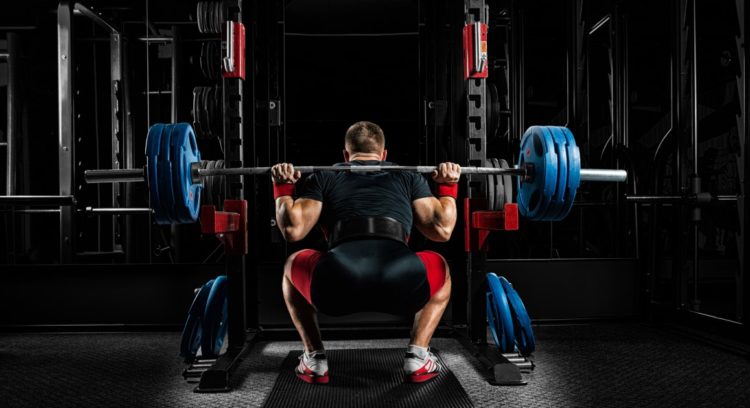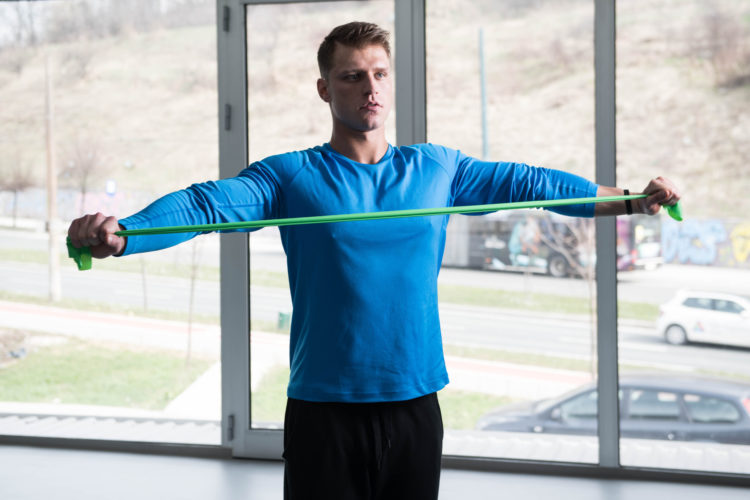4 Challenging Pull-Apart Variations For A Stronger Upper Back | BarBend (original) (raw)
Seven years ago, my right shoulder was hurting. My A/C joint was inflamed, and any bilateral pressing movements were out of the question. Life in and outside the gym sucked.
The only option was to give in and do physical therapy, and during my initial consultation, the PT tested my upper back strength in a variety of positions.
This humbled me. My upper back and shoulder strength was virtually nonexistent. Which surprised me because chin ups, pull ups and row variations were (and still are) a huge part of my training.
But I was performing them incorrectly because I was not engaging the upper back muscles. The muscles of the rear deltoids, rhomboids and trapezius are out of sight, out of mind, until it is too late.
And the exercise that helped me the most during physical therapy was the band pull-apart.
How To Perform The Basic Band Pull-Apart
- Hold the band at shoulder width with palms facing up or down.
- Tighten your abdominals and keep your shoulders down and chest up
- Retract your shoulder blades and spread the band apart.
- Pull using your rear deltoids and shoulder blades and not your arms. Return to start under control
Note: Avoid shrugging with your upper traps with most pull-apart variations. Do this by keeping your shoulders away from your ears.
The Muscles And Movements It Trains
A good band pull-apart trains the
- Rear Deltoids
- Rhomboids
- Trapezius
- Rotator cuffs
The movement it trains is scapular retraction (bringing of the shoulder blades together).
[Related: 10 exercises for stronger, healthier scaps]

Image via Shutterstock/Andy Gin
The Importance Of The Upper Back
The band pull-apart is a simple isolation exercise to target the upper back muscles and a great way to add more pulling volume to your training. And the upper back is important because:
- It plays a role in keeping the spine in neutral during squats, deadlifts, and row variations.
- It plays a role in keeping the bar close to you when you are pulling from the floor.
- It prevents a back squat from turning into a good morning.
- It provides a “shelf” for the back squat.
- A strong and engaged upper back supports and controls the bar path while bench pressing.
- It helps support your head and improve posture.

Jasminko Ibrakovic /Shutterstock
How To Program Band Pull-Aparts
You have a couple of options here. Band pull-aparts are a great warm up exercise performed for anywhere between 15-25 reps. Or paired in a superset when performing a strength pressing movement. For example,
1A. Overhead shoulder press 3-6 reps
1B. Pull- apart variation 10-25 reps
But you can also keep a band at your desk and do a few sets any time of the day. You’ll soon notice it’s helping to keep your shoulders back and your posture on point.
If you’re getting bored of your standard pull-aparts or you think your scaps are ready for a new challenge, consider these.
2. 3 Position Pull-Apart
This variation trains all the positions your hands (and shoulders) could be in, palms down, neutral and palms up. The neutral and palms up trains your external rotator cuffs while the palm down trains your internal rotators.
[Related: The best resistance band accessories for powerlifters]
3. 3D Pull-Apart
If regular band pull-aparts are easy, then this is for you. You will train your entire shoulder area as well as your upper back. You have two options when doing this.
- Perform a front raise and then pull apart, back down and repeat
- Perform a front raise, stay there, and perform all your pull-apart reps.
Either way, it’ll burn the right way.
4. Band Tall Kneeling Pull-Apart
By taking your lower body out of the equation, you will increase the intensity and train your core and hip stability too. If you have a habit of extending your lower back while doing any pulling exercise, this will make you more aware of it.
[Related: Why you should try lifting weights from a kneeling position]
5. Bent-Over Band Pull-Apart
This is a great variation to train your upper back strength and endurance where you need it most: in the hinge position ready to rip the barbell off the floor. By pulling to the 3 different positions, you will train the upper back muscles from different angles.
And by spending time in the hinge, you will improve muscular endurance in your lower back and hamstrings.

Bojan Milinkov/Shutterstock
Wrapping Up
The upper back is important for performance, shoulder health and you will neglect it at your peril. The band pull-apart and its variations give you an easy way to build strength and endurance in the upper back.
Make sure to turn and flex to admire your handy work.
Featured image via Bojan Milinkov/Shutterstock